Evaluation of Water Quality Interaction by Dam and Weir Operation Using SWAT in the Nakdong River Basin of South Korea
Abstract
1. Introduction
2. Materials and Methods
2.1. Study Area Description
2.2. SWAT Model Description
2.3. Data Collection and Analysis Method
2.3.1. GIS, Weather, and Hydrological Monitoring Data
2.3.2. Simulation Scenarios
2.3.3. Research Method
3. Results and Discussion
3.1. Calibration and Validation of the Model
3.2. Analysis of Streamflow and Water Quality Interaction in 2017 According to the Dam-Weir Combined Operation Scenarios
4. Summary and Conclusions
- (1)
- The calibration and validation results for the inflow and storage of 10 dam and weir points in the Nakdong River Basin showed R2 values that ranged from 0.71 to 0.90 and NSE values that ranged from 0.59 to 0.78. RMSE ranged from 1.14 to 1.69 mm/day, and PBIAS exhibited statistical values between −18.04 and 7.32%. The water quality R2 results revealed that the R2 of SS ranged from 0.58 to 0.83 and that that of T-N ranged from 0.53 to 0.68. T-P exhibited a correlation between 0.56 and 0.79. The results showed that the statistical analysis results were significant for all the calibration and validation points.
- (2)
- Dam-weir operation scenarios were selected among the eight dam-weir-reservoir combined operation scenarios published by the Ministry of Environment (ME), the Ministry of Land, Infrastructure, and Transport (MOLIT), and the Ministry of Agriculture, Food and Rural Affairs (MAFRA) on 20 March 2017. For the years 2016 and 2017, when weir release was initiated, daily release data were constructed, then simulation was performed for each scenario, and the results were finally analyzed.
- (3)
- The average annual streamflow in 2017 was analyzed by scenario, and the average annual flow rate of the entire Nakdong River Basin in observed data was found to be 28.7 m3/s. Scenarios 2, 3, 4, and 5 exhibited increases in the average annual streamflow by 0.13~0.79 m3/s compared to the observed data due to the simultaneous release of the dams and weirs. However, water quality improvement and deterioration phenomena were different in each section.
- (4)
- The monthly changes in streamflow and water quality (SS, T-N, and T-P) from June to December in 2017 were analyzed, and Scenarios 4 and 8 exhibited water quality improvement effects compared to the observed data. The results showed that water quality improvement could be maintained through sequential weir operation while minimizing the operation of the hydrological facility.
Author Contributions
Funding
Conflicts of Interest
References
- Ahn, J.M.; Lee, S.; Kang, T. Evaluation of dams and weirs operating for water resource management of the Geum River. Sci. Total Environ. 2014, 478, 103–115. (In Korean) [Google Scholar] [CrossRef]
- Na, E.H.; Park, S.Y.; Kim, J.H.; Im, S.S.; Kim, K.H. A study on spatial and temporal patterns of water quality in the middle area of the Nakdong River, Korea. J. Korean Soci. Water Environ. 2015, 31, 723–731. (In Korean) [Google Scholar] [CrossRef]
- Ministry of Environment. Occurrence of Algae (Green Algae) and Corresponding Annual Report; Ministry of Environment: Sejong-si, Korea, 2016; pp. 3–7. (In Korean)
- Ministry of Environment. A Study on the Water Quality Management and Construction of Watergate Link Model Considering Beam and Repair Operation Law Preparation; Research Report; Ministry of Environment: Sejong-si, Korea, 2015; p. 64. (In Korean)
- Fang, H.; Cheng, Y.; Yan, S. Optimization on water resource system operation policy during drought. J. Water Resour. Prot. 2011, 3, 140. [Google Scholar] [CrossRef]
- Ahn, J.M.; Cha, K.U.; Ryoo, K.S.; Lyu, S. Study of the lower duration curve characteristic by reservoir and weir couple-operating system in Geum River basin. J. Korea Water Resour. Assoc. 2011, 44, 285–293. (In Korean) [Google Scholar] [CrossRef][Green Version]
- Kim, S.K. Coordinated operation of weirs and reservoirs of Nakdong River basin after the four-river restoration project. Water Future 2012, 45, 11–17. (In Korean) [Google Scholar]
- Ahn, J.M.; Im, T.H.; Lee, I.J.; Lee, K.L.; Jung, K.Y.; Lee, J.W.; Cheon, S.U.; Park, I.H. A study on efficiency of water supply through conjunctive operation of reservoirs and multi-function weirs in the Nakdong River. J. Korean Soc. Water Environ. 2014, 30, 138–147. (In Korean) [Google Scholar] [CrossRef]
- Jang, C.H. A Study on the Reevaluation of Dams and Coordinated Operation with Weirs in the Nakdong River Basin. Master’s Thesis, Seoul National University, Seoul, Korea, 2014. (In Korean). [Google Scholar]
- Lee, S.J.; Kim, J.W.; Lee, H.J.; Han, J.H. Analysis of Water Quality improvement of Conjunctive Operation of Weirs in the Nakdong River. In Proceedings of the Korean Society of Civil Engineers 2014 Convention, Daegu, Korea, 23–24 October 2014; pp. 195–196. (In Korean). [Google Scholar]
- Ryu, S.H.; Lee, I.C.; Jang, T.Y.; Kim, K.H. Analysis of water quality variation by weir construction in the Nakdong river basin. In Proceedings of the Korean Society for Marine Environment and Energy, Tongyeong, Korea, 19–20 November 2015; pp. 16–20. (In Korean). [Google Scholar]
- Lin, N.; Rutten, M. Estimation of reservoir inflow in data scarce region by using Sacramento rainfall runoff model—A case study for Sittaung River Basin, Myanmar. EGU Gen. Assem. Conf. Abstr. 2017, 19, 15891. [Google Scholar]
- Ahn, J.M.; Jung, K.Y.; Shin, D. Effects of coordinated operation of weirs and reservoirs on the water quality of the Geum River. Water 2017, 9, 423. [Google Scholar]
- Ahn, J.M.; Yang, D.S.; Jung, K.Y.; Shin, D.S. Assessing the coordinated operation of reservoirs and weirs for sustainable water management in the Geum River basin under climate change. Water 2018, 10, 30. [Google Scholar]
- Li, Y.; Cui, Q.; Li, C.; Wang, X.; Cai, Y.; Cui, G.; Yang, Z. An improved multi-objective optimization model for supporting reservoir operation of China’s South-to-North water diversion project. Sci. Total Environ. 2017, 575, 970–981. [Google Scholar] [CrossRef]
- Sun, X.; Luo, J.; Xie, J. Multi-Objective optimization for reservoir operation considering water diversion and power generation objectives. Water 2018, 10, 1540. [Google Scholar] [CrossRef]
- Arnold, J.G.; Williams, J.R.; Srinivasan, K.; King, W. SWAT Manual, USDA; Agricultural Research Service and Black land Research Center: Temple, TX, USA, 2005. [Google Scholar]
- Neitsch, S.L.; Arnold, J.G.; Kiniry, J.R.; Williams, J.R. Soil and Water Aseessment Tool (SWAT) Theoretical Documentation; Texas Water Reosurces Institute Technical Report; Texas A&M University: Temple, TX, USA, 2001; pp. 340–367. [Google Scholar]
- Ahn, J.M.; Lyu, S. Analysis of the coordinated operation of reservoirs and weirs during the management of Nakdong River water resources. J. Water Res. Plan. Manag. 2017, 143, 04017030. [Google Scholar] [CrossRef]
- Ahn, S.R.; Lee, J.W.; Jang, S.S.; Kim, S.J. Large scale SWAT watershed modeling considering multi-purpose dams and multi-function weirs operation—For Namhan River basin. J. Korea Soc. Agric. Eng. 2016, 58, 21–35. (In Korean) [Google Scholar]
- Ahn, S.R.; Kim, S.J. Analysis of water balance by surface–groundwater interaction using the SWAT model for the Han River basin, South Korea. Paddy Water Environ. 2018, 16, 543–560. [Google Scholar] [CrossRef]
- Lee, J.; Jung, C.; Kim, S.; Kim, S. Assessment of climate change impact on future groundwater-level behavior using SWAT groundwater-consumption function in Geum River basin of South Korea. Water 2019, 11, 949. [Google Scholar] [CrossRef]
- Nash, J.E.; Sutcliffe, J.V. River flow forecasting through conceptual models part I—A discussion of principles. J. Hydrol. 1970, 10, 282–290. [Google Scholar] [CrossRef]
- Mkhwanazi, M.; Chavez, J.L.; Rambikur, E.H. Comparison of Large aperture scintillometer and satellitebased energy balance models in sensible heat flux and crop evapotranspiration determination. Int. J. Remote Sens. Appl. 2012, 12, 24–30. [Google Scholar]
- Donigian, A.S., Jr. HSPF Training Workshop Handbook and CD. Lecture #19. Calibration and Verification Issues, Slide #L19-22; Presented and prepared for U.S. EPA, Office of Science and Technology; EPA Headquarters, Washington Information Center: Washington, DC, USA, 2000. [Google Scholar]
- Ministry of Environment. Optimal Linkage Operation Plan of Dam-Weir-Reservoir; Ministry of Environment: Sejong-si, Korea, 2017. (In Korean)
- Reid, I.; Bathurst, J.C.; Carling, P.A.; Walling, D.E.; Webb, B.W. Sediment erosion, transport and deposition. In Applied Fluvial Geomorphology for River Engineering and Management; Thorne, C.R., Hey, R.D., Newson, M.D., Eds.; John Wiley & Sons: Chichester, UK, 1997; pp. 106–113. [Google Scholar]
- Walling, D.E.; Moorehead, P.W. The particle size characteristics of fluvial suspended sediment: An overview. Hydrobiologia 1989, 176, 125–149. [Google Scholar] [CrossRef]
- Surbeck, C.Q.; Jiang, S.C.; Ahn, J.H.; Grant, S.B. Flow fingerprinting fecal pollution and suspended solids in stormwater runoff from an urban coastal watershed. Environ. Sci. Technol. 2016, 40, 4435–4441. [Google Scholar] [CrossRef]
- Zhang, H.; Huang, G.H.; Wang, D.; Zhang, X.; Li, G.; An, C.; Chu, Z.; Liao, X.; Nie, X. An integrated multi-level watershed-reservoir modeling system for examining hydrological and biogeochemical processes in small prairie watersheds. Water Res. 2012, 46, 1207–1224. [Google Scholar] [CrossRef]
- Shen, Z.; Qiu, J.; Hong, Q.; Chen, L. Simulation of spatial and temporal distributions of non-point source pollution load in the Three Gorges Reservoir Region. Sci. Total Environ. 2014, 493, 138–146. [Google Scholar] [CrossRef] [PubMed]
- Shi, Y.; Xu, G.; Wang, Y.; Engel, B.A.; Peng, H.; Zhang, W.; Cheng, M.; Dai, M. Modelling hydrology and water quality processes in the Pengxi River basin of the Three Gorges Reservoir using the soil and water assessment tool. Agric. Water Manag. 2017, 182, 24–38. [Google Scholar] [CrossRef]

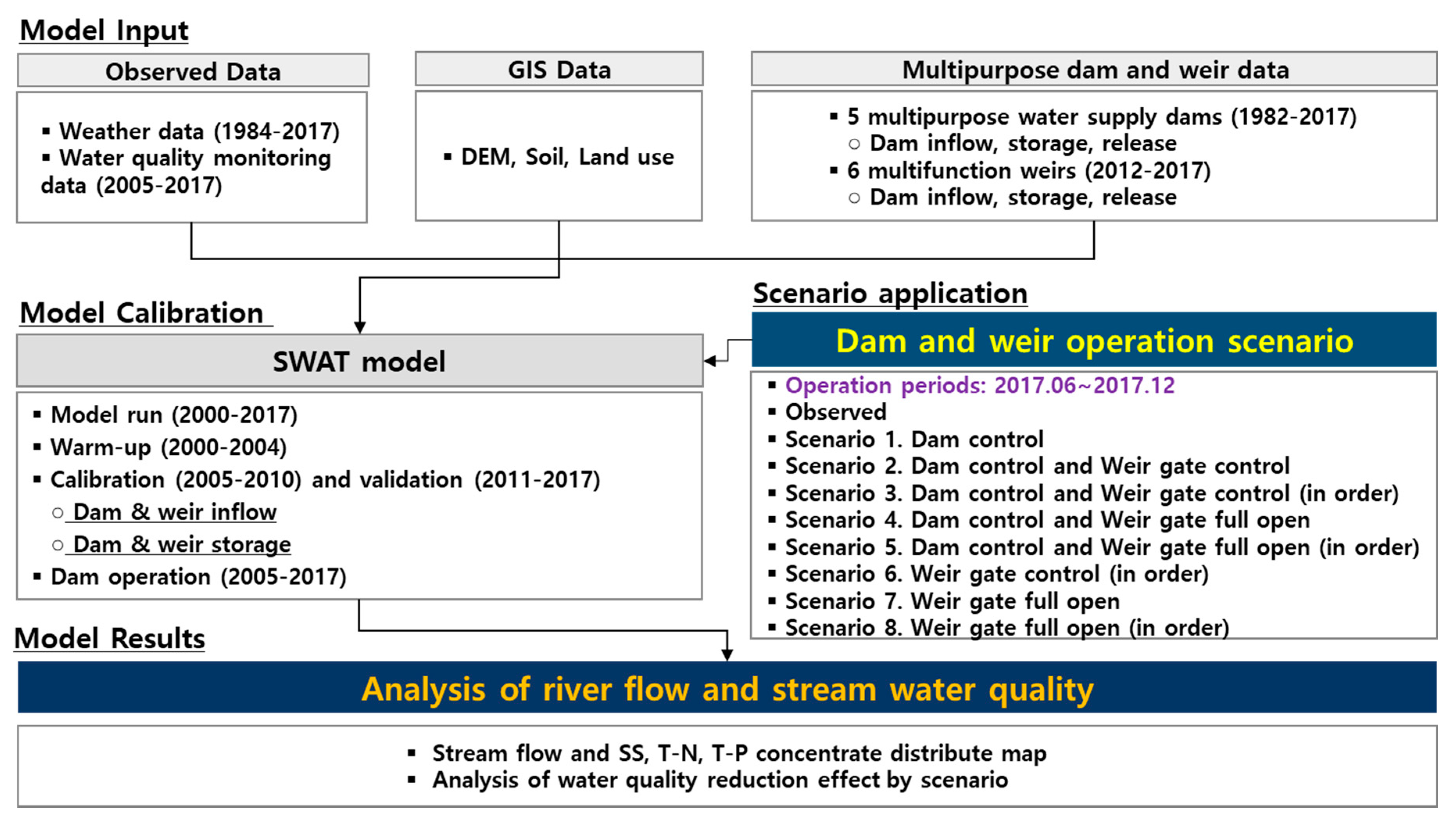
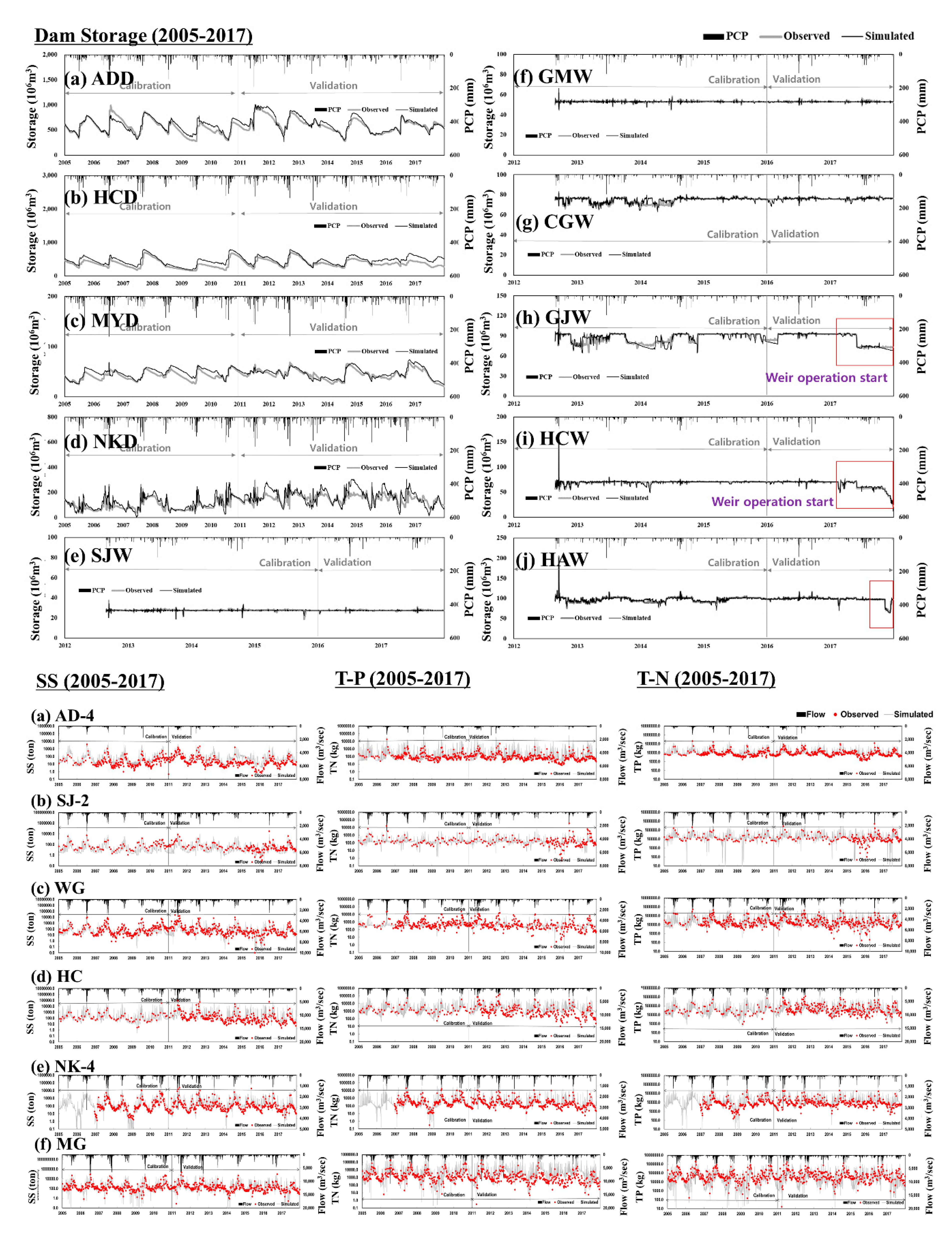
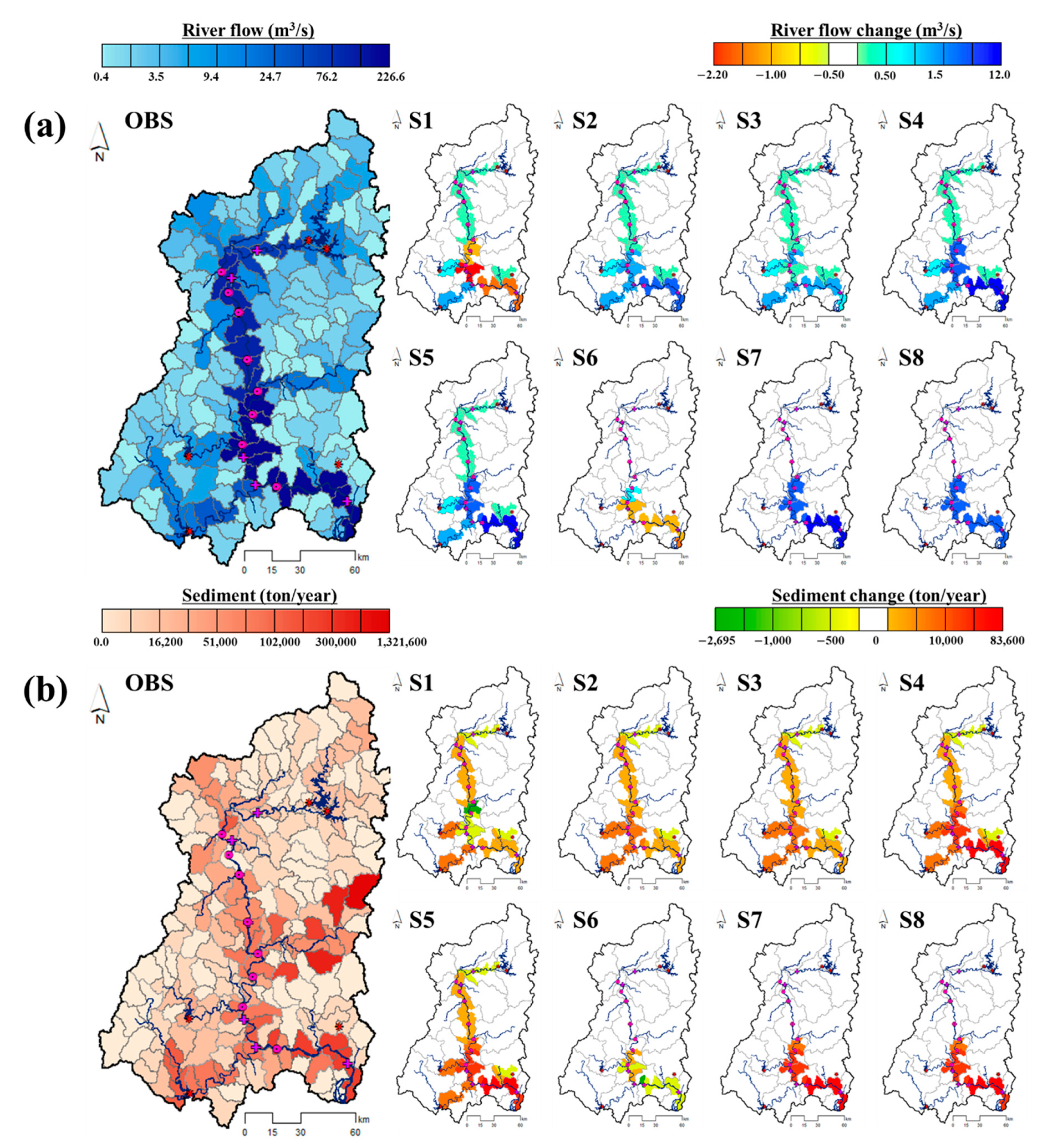
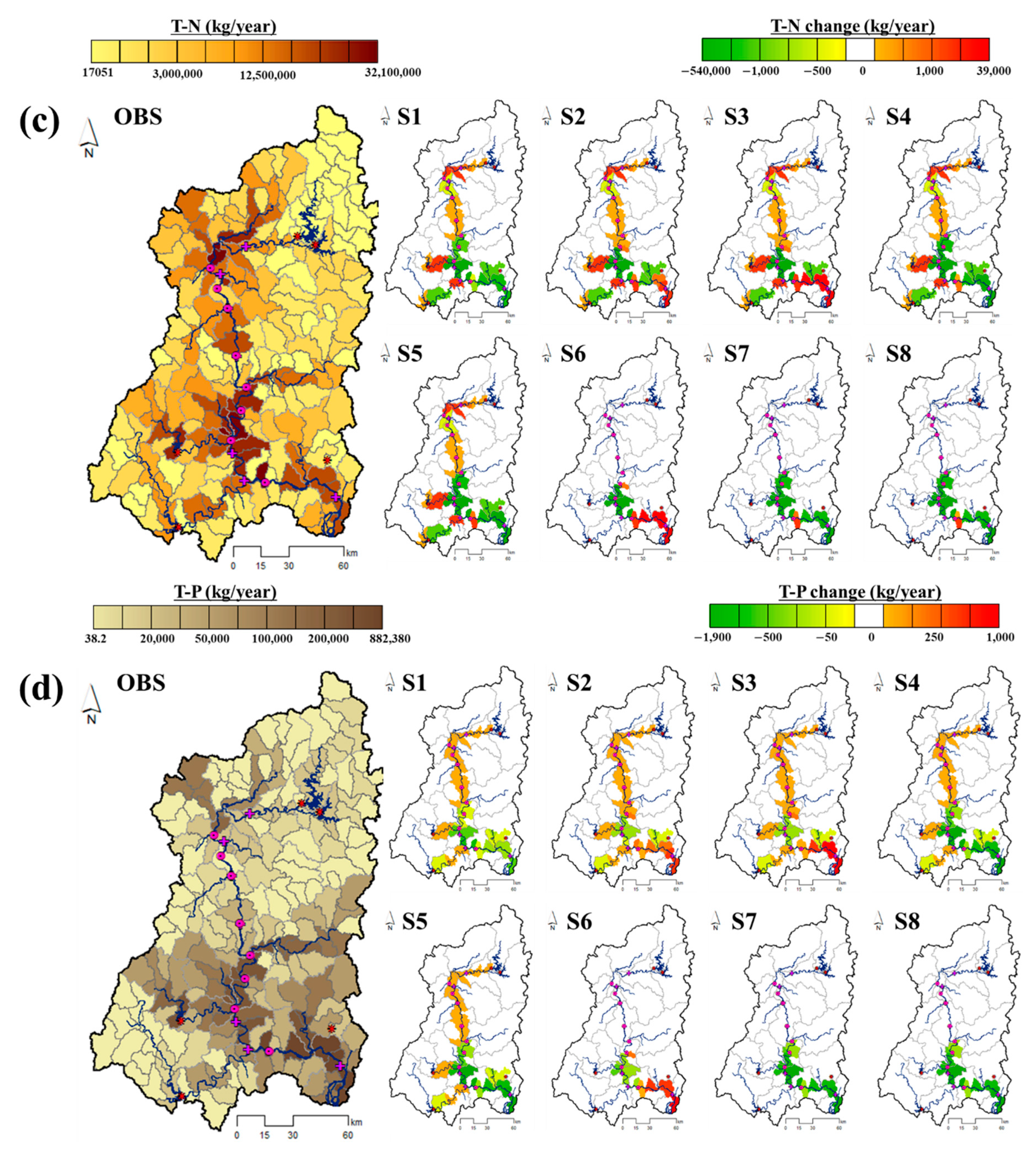

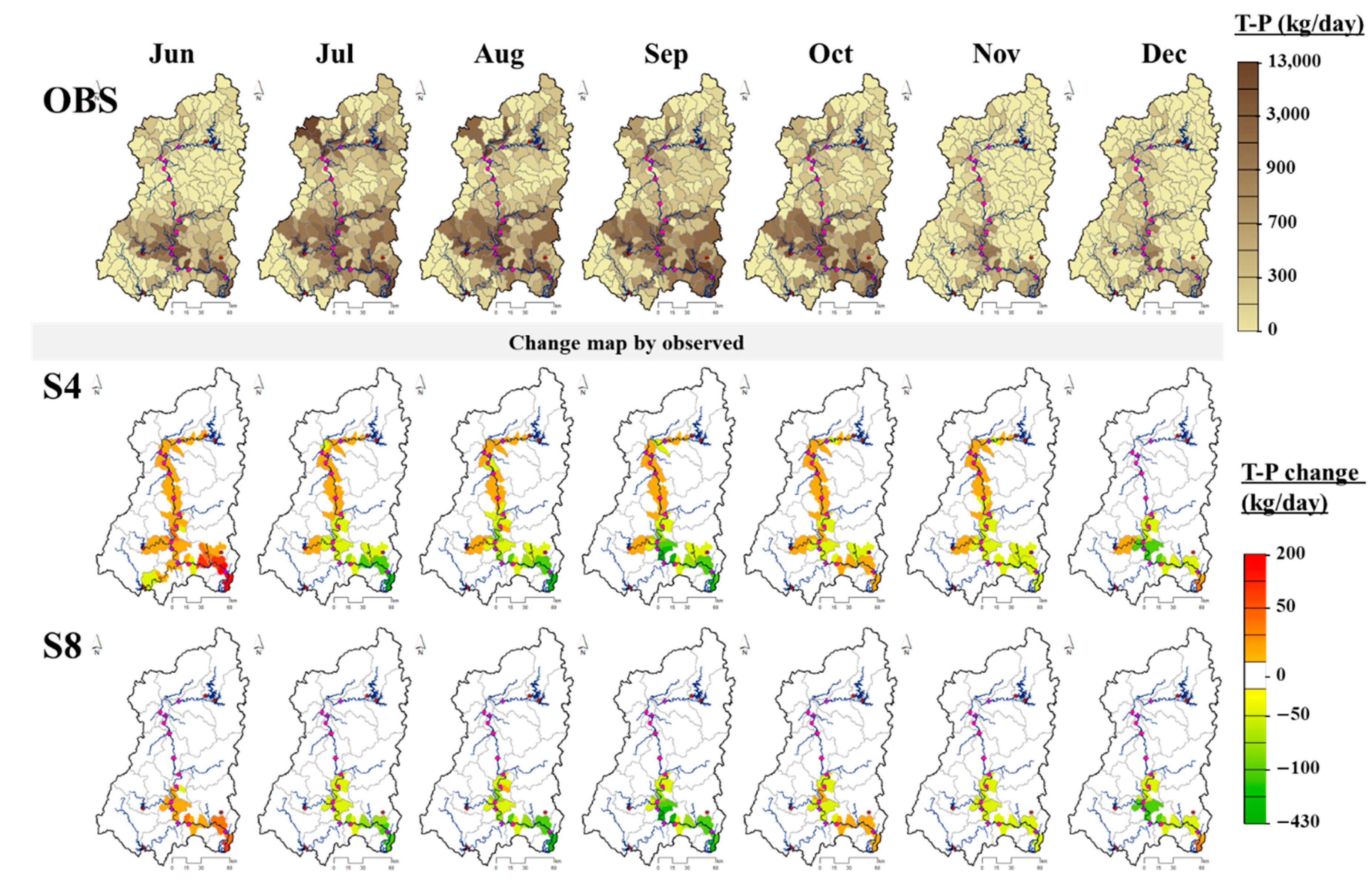
| Station | SS (mg/L) | T-N (mg/L) | T-P (mg/L) | Condition of River Water | ||
|---|---|---|---|---|---|---|
| Dam & Weir | WQ Monitoring | |||||
| Upstream | ADD, IHD | AD-4 | 5.87 | 2.144 | 0.034 | Good |
| SJW | SJ-2 | 14.70 | 2.43 | 0.035 | Good | |
| CGW | WG | 11.17 | 2.96 | 0.092 | Good | |
| Downstream | GJW, DSW, HCW, HCD | HC | 27.30 | 3.28 | 0.156 | Fair |
| NKD | NK-4 | 42.89 | 3.11 | 0.139 | Fair | |
| HAW, MYD | MG | 17.97 | 3.06 | 0.135 | Fair | |
| Dam | Reservoir Level (EL.m) | Reservoir Storage (103 m3) | ||||
|---|---|---|---|---|---|---|
| MWL | FRL | MDDL | MWL | FRL | MDDL | |
| ADD | 161.7 | 160.0 | 130.0 | 1,309,920 | 1,216,420 | 228,320 |
| IHD | 164.7 | 163.0 | 137.0 | 614,320 | 565,580 | 122,420 |
| HCD | 179.0 | 176.0 | 140.0 | 801,150 | 724,070 | 150,570 |
| NKD | 46.0 | 41.0 | 32.0 | 346,190 | 182,370 | 16,130 |
| MYD | 210.2 | 207.2 | 150.0 | 76,241 | 69,897 | 3254 |
| Weir | Operating Water Surface Elevation (EL.m) | Weir Storage (103 m3) | ||||
| Flood | Conservation | Minimum | Flood | Conservation | Minimum | |
| SJW | 49.60 | 47.0 | 43.6 | 36,804 | 27,400 | 12,500 |
| NDW | 43.69 | 40.0 | 37.4 | 50,851 | 34,700 | 22,200 |
| GMW | 35.52 | 32.5 | 22.6 | 73,387 | 52,700 | 500 |
| CGW | 28.39 | 25.5 | 24.5 | 109,470 | 75,300 | 76,200 |
| GJW | 24.02 | 19.5 | 14.9 | 152,423 | 92,300 | 44,900 |
| DSW | 21.86 | 14.0 | 6.6 | 147,389 | 58,600 | 3200 |
| HCW | 18.57 | 10.5 | 2.3 | 169,701 | 70,000 | 8900 |
| HAW | 13.65 | 5.0 | 1.5 | 272,870 | 100,900 | 44,900 |
| Scenario | OBS | S1 | S2 | S3 | S4 | S5 | S6 | S7 | S8 | ||
|---|---|---|---|---|---|---|---|---|---|---|---|
| DAM control | O | O | O | O | O | ||||||
| Weir | Gate control | Release at the same time | O | O | |||||||
| Release with one-month interval from upstream to downstream | O | O | |||||||||
| Gate full open | Release at the same time | O | O | ||||||||
| Release with one-month interval from upstream to downstream | O | O | |||||||||
| Parameter | Definition | Range | YDD | SJW | GMW | CGW | CJW | HCW | HCD | MYD | NKD | HAW | ||||
|---|---|---|---|---|---|---|---|---|---|---|---|---|---|---|---|---|
| Runoff | ||||||||||||||||
| CN2 | SCS curve number for moisture condition | 35 to 98 | +5 | - | - | +5 | +5 | - | - | +10 | +10 | +5 | ||||
| CH_N (2) | Manning’s “n” value for main channel | 0.01 to 30 | 0.04 | 0.04 | 0.04 | 0.04 | 0.04 | 0.04 | 0.014 | 0.04 | 0.014 | 0.04 | ||||
| Evapotranspiration | ||||||||||||||||
| ESCO | Soil evaporation compensation coefficient | 0 to 1 | 0.95 | 0.75 | 0.75 | 0.75 | 0.95 | 0.95 | 0.95 | 0.95 | 0.95 | 0.95 | ||||
| CANMX | Maximum canopy storage | 0 to 100 | 11 | - | - | - | - | - | - | 8 | 7 | - | ||||
| Lateral flow | ||||||||||||||||
| SLOIL | Slope length of lateral subsurface flow (m) | 0 to 150 | 5 | 5 | 5 | 5 | 5 | 5 | 5 | 5 | 5 | 5 | ||||
| LAT_TIME | Lateral flow travel time (days) | 0 to 180 | 5 | 5 | 5 | 5 | 5 | 5 | 5 | 5 | 5 | 5 | ||||
| Groundwater | ||||||||||||||||
| GW_DELAY | Delay time for aquifer recharge (days) | 0 to 500 | 90 | 31 | 31 | 50 | 80 | 70 | 150 | 70 | 150 | 70 | ||||
| GWQMN | Threshold water level in shallow aquifer for base flow (mm) | 0 to 5000 | 1000 | 1000 | 1000 | 1000 | 1000 | 1000 | 1000 | 500 | 1000 | 1000 | ||||
| ALPHA_BF | Base flow recession constant | 0 to 1 | 0.048 | 0.048 | 0.048 | 0.048 | 0.048 | 0.048 | 0.048 | 0.024 | 0.048 | 0.048 | ||||
| Reservoir | ||||||||||||||||
| RES_ESA | Reservoir surface area when the reservoir is filled to the emergency spillway (ha) | - | 5617 | 335 | 374 | 400 | 954 | 328 | 2636 | 218 | 549 | 3621 | ||||
| RES_EVOL | Volume of water needed to fill the reservoir to the emergency spillway (104 m3) | - | 124,800 | 2951 | 5599 | 8044 | 9719 | 7453 | 79,000 | 7624 | 10,789 | 30,920 | ||||
| RES_PSA | Reservoir surface area when the reservoir is filled to the principal spillway (ha) | - | 5384 | 305 | 344 | 370 | 924 | 298 | 2429 | 205 | 519 | 2810 | ||||
| RES_PVOL | Volume of water needed to fill the reservoir to the principal spillway (104 m3) | - | 121,642 | 2751 | 5273 | 7532 | 9234 | 6996 | 72,407 | 6990 | 10,093 | 18,237 | ||||
| RES_VOL | Initial reservoir volume (104 m3) | - | 58,290 | 2744 | 5257 | 7517 | 8655 | 6880 | 34,652 | 4386 | 10,053 | 12,706 | ||||
| RES_K | Hydraulic conductivity of the reservoir bottom (mm/hr) | 0 to 1 | 0.5 | 0.5 | 0.5 | 0.5 | 0.5 | 0.5 | 0.5 | 0.5 | 0.5 | 0.5 | ||||
| EVRSV | Lake evaporation coefficient | 0 to 1 | 0.6 | 0.6 | 0.6 | 0.6 | 0.6 | 0.6 | 0.6 | 0.6 | 0.6 | 0.6 | ||||
| Parameter | Definition | Range | AD-4 | SJ-2 | EG | HC | MK-4 | MG | ||||||||
| SS | ||||||||||||||||
| USLE_P | USLE equation support practice factor | 0 to 1 | 0.1 | 0.5 | 1 | 1 | 1 | 1 | ||||||||
| SPCON | Linear parameter for calculating the maximum amount of sediment that can be re-entrained during channel sediment routing | 0.0001 to 0.01 | 0.0001 | 0.0001 | 0.0001 | 0.0001 | 0.0001 | 0.0001 | ||||||||
| SPEXP | Exponent parameter for calculating sediment re-entrained in channel sediment routing | 1 to 1.5 | 1.5 | 1.5 | 1.5 | 1.5 | 1.5 | 1.5 | ||||||||
| T-N | ||||||||||||||||
| LAT_ORGN | Organic N in the baseflow (mg/l) | 0 to 200 | 0.17 | 20 | 20 | 80 | 10 | 20 | ||||||||
| NPERCO | Nitrate percolation coefficient | 0 to 1 | 0.25 | 0.25 | 0.25 | 0.25 | 0.25 | 0.25 | ||||||||
| SDNCO | Threshold value of nutrient cycling water factor for denitrification to occur | 0 to 1 | 1 | 1 | 1 | 1 | 1 | 1 | ||||||||
| RAMMO_SUB | Atmospheric deposition of ammonium | 0 to 1 | 0.95 | 0.95 | 0.95 | 0.95 | 0.95 | 0.95 | ||||||||
| RCN_SUB | Atmospheric deposition of nitrate | 0 to 2 | 2 | 2 | 2 | 2 | 2 | 2 | ||||||||
| T-P | ||||||||||||||||
| GWSOLP | Concentration of soluble phosphorus in groundwater contribution to streamflow from sub-basin (mg P/L or ppm) | 0 to 1000 | 0.018 | 0.1 | 0.1 | 0.4 | 0.1 | 0.4 | ||||||||
| LAT_ORGP | Organic P in the base flow (mg/L) | 0 to 200 | - | - | - | 4 | - | - | ||||||||
| Hydrology | ||||||||||||||||
|---|---|---|---|---|---|---|---|---|---|---|---|---|---|---|---|---|
| Evaluation Criteria | ADD | HCD | MYD | NKD | SJW | GMW | CGW | GJW | HCW | HAW | ||||||
| Dam inflow (mm) | R2 | 0.73 | 0.90 | 0.90 | 0.84 | 0.71 | 0.76 | 0.76 | 0.77 | 0.80 | 0.83 | |||||
| NSE | 0.59 | 0.62 | 0.78 | 0.62 | 0.63 | 0.69 | 0.68 | 0.71 | 0.61 | 0.63 | ||||||
| RMSE (mm/day) | 1.68 | 1.65 | 1.43 | 1.69 | 1.45 | 1.48 | 1.31 | 1.14 | 1.63 | 1.38 | ||||||
| PBIAS (%) | 5.97 | −2.02 | 7.32 | −18.04 | −15.06 | −14.51 | −8.56 | −15.20 | −16.31 | −10.63 | ||||||
| Dam storage (106 m3) | R2 | 0.92 | 0.90 | 0.81 | 0.72 | 0.55 | 0.52 | 0.59 | 0.72 | 0.71 | 0.88 | |||||
| NSE | 0.99 | 0.62 | 0.98 | 0.92 | 1.00 | 1.00 | 1.00 | 1.00 | 1.00 | 1.00 | ||||||
| RMSE (mm/day) | 1.31 | 1.65 | 0.50 | 0.91 | 0.14 | 0.16 | 0.16 | 0.27 | 0.21 | 0.22 | ||||||
| PBIAS (%) | 5.90 | 23.42 | 9.01 | −1.74 | −0.44 | −0.18 | 0.68 | −0.91 | −1.03 | −0.02 | ||||||
| Water Quality | ||||||||||||||||
| Evaluation Criteria | AD-4 | SJ-2 | WG | HC | NK-4 | MG | ||||||||||
| SS (ton/day) | R2 | 0.69 | 0.74 | 0.66 | 0.58 | 0.83 | 0.62 | |||||||||
| % Diff | 29.6 | 22.9 | 25.4 | 11.7 | 9.4 | 2.6 | ||||||||||
| TN (kg/day) | R2 | 0.59 | 0.53 | 0.68 | 0.54 | 0.54 | 0.56 | |||||||||
| % Diff | 2.5 | 8.6 | 2.4 | 5.4 | 14.8 | 13.4 | ||||||||||
| TP (kg/day) | R2 | 0.56 | 0.79 | 0.59 | 0.56 | 0.61 | 0.57 | |||||||||
| % Diff | 19.4 | 11.3 | 8.5 | 9.8 | 0.4 | 31.7 | ||||||||||
| Component | OBS | S1 | S2 | S3 | S4 | S5 | S6 | S7 | S8 | |
|---|---|---|---|---|---|---|---|---|---|---|
| Flow (m3/s) | 304.42 | 302.49 | 307.97 | 306.13 | 325.35 | 322.20 | 302.76 | 324.24 | 318.82 | |
| (−0.63) | (1.17) | (0.56) | (6.88) | (5.84) | (−0.55) | (6.51) | (4.73) | |||
| SS (ton/day) | 515.00 | 515.74 | 516.75 | 515.79 | 862.66 | 771.99 | 513.49 | 861.18 | 767.94 | |
| (0.14) | (0.34) | (0.15) | (67.51) | (49.9) | (−0.29) | (67.22) | (49.11) | |||
| T-N (kg/day) | 26,383.04 | 26,294.26 | 26,393.29 | 26,476.12 | 26,088.03 | 26,092.84 | 26,487.12 | 26,133.87 | 26,119.32 | |
| (−0.34) | (0.04) | (0.35) | (−1.12) | (−1.10) | (0.39) | (−0.94) | (−1.00) | |||
| T-P (kg/day) | 3976.80 | 3966.79 | 3982.50 | 3989.67 | 3919.11 | 3920.05 | 3986.53 | 3920.12 | 3919.18 | |
| (−0.25) | (0.14) | (0.32) | (−1.45) | (−1.43) | (0.24) | (−1.43) | (−1.44) | |||
| Efficiency of pollutant load reduction | SS | - | 2 | 4 | 3 | 8 | 6 | 1 | 7 | 5 |
| T-N | - | 5 | 6 | 7 | 1 | 2 | 8 | 4 | 3 | |
| T-P | - | 5 | 6 | 8 | 1 | 3 | 7 | 4 | 2 | |
| Total | - | 4 | 6 | 8 | 1 | 3 | 6 | 5 | 1 | |
© 2020 by the authors. Licensee MDPI, Basel, Switzerland. This article is an open access article distributed under the terms and conditions of the Creative Commons Attribution (CC BY) license (http://creativecommons.org/licenses/by/4.0/).
Share and Cite
Lee, J.; Lee, Y.; Woo, S.; Kim, W.; Kim, S. Evaluation of Water Quality Interaction by Dam and Weir Operation Using SWAT in the Nakdong River Basin of South Korea. Sustainability 2020, 12, 6845. https://doi.org/10.3390/su12176845
Lee J, Lee Y, Woo S, Kim W, Kim S. Evaluation of Water Quality Interaction by Dam and Weir Operation Using SWAT in the Nakdong River Basin of South Korea. Sustainability. 2020; 12(17):6845. https://doi.org/10.3390/su12176845
Chicago/Turabian StyleLee, Jiwan, Yonggwan Lee, Soyoung Woo, Wonjin Kim, and Seongjoon Kim. 2020. "Evaluation of Water Quality Interaction by Dam and Weir Operation Using SWAT in the Nakdong River Basin of South Korea" Sustainability 12, no. 17: 6845. https://doi.org/10.3390/su12176845
APA StyleLee, J., Lee, Y., Woo, S., Kim, W., & Kim, S. (2020). Evaluation of Water Quality Interaction by Dam and Weir Operation Using SWAT in the Nakdong River Basin of South Korea. Sustainability, 12(17), 6845. https://doi.org/10.3390/su12176845






